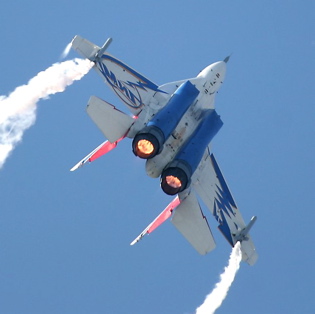
Mig-35 [Mig290VT export model]
Photo by Richard Seaman
Aviation companies from around the world have flocked to the India air show, hoping for a piece of the billions of dollars in defense contracts the fast-growing South Asian country plans to spend in modernizing its military.
It is the first time that U.S. combat aircraft makers Lockheed Martin Corp. and Boeing Co. will fly the F-16 and F/A-18 Super Hornet at the Bangalore air show. Both companies are vying for orders from the Indian air force.
But they face stiff competition from the Russian Aircraft Corporation, which manufactures the MiG combat jets and will be showing the MiG-35, the latest fighter jet in Russia’s stable. Other rivals are the Gripen, from Swedish manufacturer Saab AB, and the Eurofighter, made by BAE Systems PLC, Europe’s largest defense contractor.
“We don’t want to have a buyer-seller relationship. We will buy, but technology transfer must be there and we must be involved in designing, development and co-production,” the Indian defense minister said Wednesday.
India has been reluctant to sign deals with U.S. arms suppliers over fears that Washington could impose sanctions as it did in 1998 after India tested nuclear weapons, choking off vital spare parts and technology.
Continuity alone gives the Mig-35 the edge. Outsourcing production to India has already been agreed to by the Russians.
India’s military aircraft spending target is $12 billion. Should be a hell of a show.















The only thing you can buy from American defense firms is a stripped down export version or our aircraft. Basically you’re just getting a shell of what our front line military uses. And then we’ll use our strong-arm foreign policy tactics to keep you in line by denying the aircraft after you’ve paid for them. Or we’ll deny you training and spare parts which were paid for with the sale if you deviate from our foreign policy stance. Why in the hell would anybody want to buy from us when so many conditions are attached?
India is aware that the changing political world might leave it with an airfield of white Indian elephants, given US transigence, or maybe commit Indian forces to participate in any future allied actions in the Gulf region. My bet is on the Eurofighter or the Saab, both apolitical choices. The Saab is a tough, sturdy plane and the Eurofighter is autonomous and precise.
Like the guy said in “Armaggedon”: “Russian, American; circuit boards all made in China.”
Yeah. And chinese missiles are as accurate as american missiles.
C’mon people,do you really think that the next wars are really going to use hardware made in America? The first hint is the Kalashnikov. Or the Uzi. Then there’s the Toyota Hilux. Have you ever seen news reels of rebels anywhere, either Africa or Asia? What are they riding? Not Hummers, I can tell.
Let’s face it. The current crop of guerilla wars are not suited for american hardware.
How about the new Chinese fighter jet?
J-10 Fighter Linked to Failed U.S.-Israeli Project
The People’s Liberation Army Air Force (PLAAF) is expected to unveil its long-anticipated fourth-generation combat jet this week during the Zhuhai air show. Despite being touted as the first indigenous fighter, the J-10 is filled with a combination of technologies either bought or stolen from America.
The Chengdu J-10 advanced combat fighter is clearly a product of years of military cooperation between Israel and China, taking much of its design from the now defunct U.S.-Israeli Lavi project.
The exact amount of Israeli support for the J-10 project is debatable; however, there is overwhelming evidence that much of the new jet fighter’s design comes from the joint U.S.-Israeli project from the 1980s.
Externally, the J-10 appears to be almost an exact copy of the Israeli/U.S.-designed Lavi fighter. The aircraft is a single-seat, multi-role, delta-canard fighter design equipped with a digital fly-by-wire system for control.
Chinese engineers, working with Russian counterparts, modified the aircraft to be powered by a single Saturn Lyuika Al-31 power plant. The new power plant, more powerful that the U.S.-made engine designed for the Lavi, gives the J-10 a higher top speed and longer-range performance.
http://www.dvorak.org/blog/?p=9677
Heja Gripen!